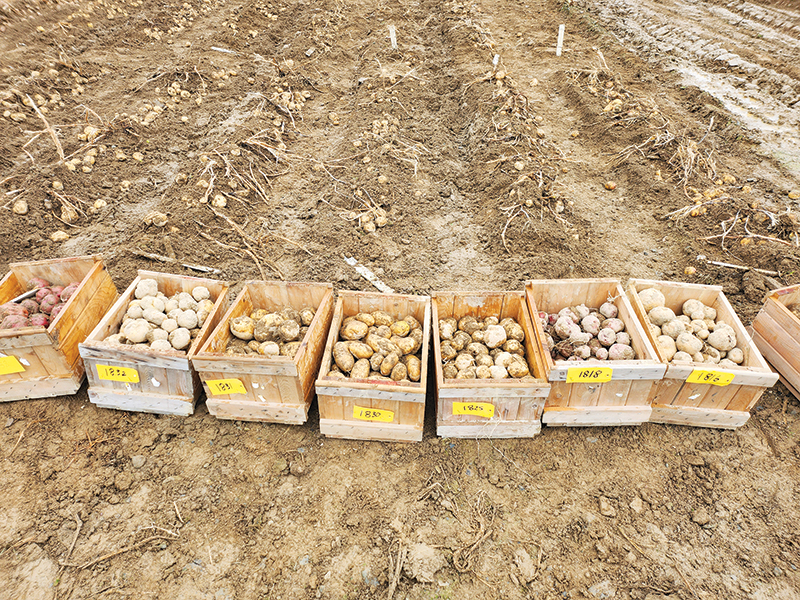
Developing new potato varieties requires perseverance
Paul Collins is a patient man. His job as a research geneticist for the USDA’s Agricultural Research Service requires him to be.
Collins is leading potato varietal development efforts in Orono, Maine, in conjunction with the University of Maine. The Eastern Potato Breeding Group Seed Nursery project aims to increase and distribute seed of potato breeding lines for field trials across Florida, Maine, North Carolina, New York, Ohio, Pennsylvania and Virginia.
Success would mean new cultivars resistant to disease and tolerant of heat with the capacity for widespread agricultural impact. Achieving that is a painstaking process — and a slow one.
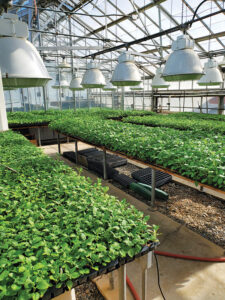
Collins recently took time from his busy research schedule to explain how the project is working toward that goal to Spudman.
Can you give us some program background?
Paul Collins (PC): ARS started breeding potatoes in Maine in 1929. At that point it was called the National Potato Breeding Program. At some point, probably about 40 or 50 years after it started, ARS also opened a potato breeding program in Idaho. They changed the names and divided it into potato breeding for the eastern U.S. and potato breeding for the western U.S.
Since then, they’ve had five breeders. I’m the fifth breeder in that line of succession. I started in 2021 with ARS. The program that I inherited focused on chippers and tables. There were also some projects working with diploid potatoes. I’ve continued in those market classes.
Tell us a little bit more about the chipping and table markets.
PC: For chippers, there’s a focus on the southeastern U.S. Specifically, Florida and North Carolina are big collaborators with us. We’re trying to find fresh market chippers that do well in really hot climates of the Southeast because of their importance to the chipping industry. Most chippers are grown in the North and can be stored for a long time, but eventually the storages run out before the next harvest, and that coincides with the harvest schedule in the Southeast.
With the tables, we have a pretty big range, from round white tables to red skin with white flesh, and then some specialty stuff as well, with purples, yellow flesh, some stuff with purple flesh, red flesh — everything that will fall under a table.
Diploids are obviously more efficient to breed, with two fewer copies of chromosomes than traditional tetraploids. What other advantages do they bring?
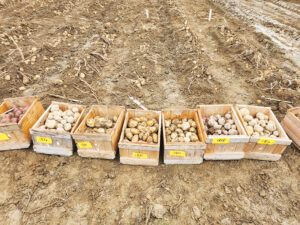
PC: Diploid potatoes are starting to attract a lot of attention in both the public and private sectors. There’s an effort to develop an F1 hybrid that could propagated through true seeds, and unlike most true-seeded potatoes, the F1 hybrids would be uniform. Instead of growers and breeders bulking up a single hill eventually into a commercial variety, you could start with hundreds or even thousands of true seed that would be uniform, and that would expedite the process of bulking up seed. Another benefit of that is that true seed transmits less virus than vegetatively propagated seed pieces from tubers. Also, the transportation cost of true seed is extremely low compared to seed tubers because you’ve got huge differences in weight.
(Diploids) have been selected in North America for adaptation to long days and other types of agronomic traits — deep yellow and orange fleshes that you really don’t see in the tetraploid gene pool.
What are some key traits the project is focused on developing?
PC: Disease and heat are two are the big ones. There’s also standard agronomic traits. Every new potential variety has to yield competitively with what’s currently on the market. Maturity is also pretty important, especially for southeast (potatoes). They have a fairly short growing window. The shorter time they’re
in the field, the less problems can arise, because they have really high pest pressure and abiotic pressure as well, because it’s so hot and they don’t really have winter to kill off a lot of the pathogens that are in the soil. Then there’s market-specific ones, so for chippers, gravity and chip quality is really important. For tables, the darkness of the red skin is pretty important.
What diseases are most important to prevent?
PC: We regularly screen for common scab, late blight and early blight. We have also got some research projects that are looking at soft rot. Sometimes it’s called black leg soft rot. A new thing that we’re starting to look at is wart resistance. Wart currently isn’t a problem in the U.S., but it’s been in Canada for decades. There’s been some reports recently where it’s been spreading into Prince Edward Island from Newfoundland, so it’s moving south towards the U.S., and geographically, if it continues in that trend, Maine would be the first state in the U.S. to encounter that. Since breeding’s such a long-term process, we’re trying to look 10, 15 years down the road — what might people need?
Can you walk us through the process of developing a new variety?
PC: This time of year (mid-October), we’ve almost finished harvest. I’m going through the data I collected in the field during harvest and making selections for my parents. I’m seeing which ones (will work) for the breeding program, and we also have a few hundred historical lines that we grow, so I’m also looking at those for potential parents. I’m looking at everything we grew this year, seeing what has the best field performance, what has resistance traits, what has unique genetics that might be beneficial to use as a parent.
I will select about 100 to 150 lines to plant in the greenhouse here in Orono. We’ll get that planted in early December, and then by late January, early February, they’ll start flowering. At that point, we start crossing — taking pollen from the males, putting it on a microscope slide and then tapping that onto the flowers of the female parent of that crop. We’ll tag it, collect the fruits, extract the seeds, and then in the spring, while we’re planting all the trials at the research farm, we’ll also plant out seedling generations here in Orono.
What does the planting process look like?
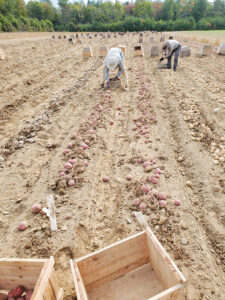
PC: I grow plants in 50-cell trays, and then transplant the seedlings into those trays. At the end of the year, we’ll harvest those trays and get mini-tubers, and we’ll take one mini-tuber from each cell. Those are the mini-tubers that, the next year, we’ll send to the research farm, and those mini-tubers will be space planted about three feet apart.
We grow about 30,000 seedlings every year, so we have about 30,000 single hills. That first year, we eliminate 98% of them. A lot of them have growth cracks, other external defects, weird shapes, low yields, late maturity. For the tables, the skin color is a big selection factor, so for the reds, a lot of the progeny between two dark red crosses is going to be pink, so we have to eliminate all the pink tubers at that stage.
Then we take the best 2%, so that ends up being about 500 or 600 lines. The following year, those are planted in 12-hill plots. Around 20% of those are selected. Each year, the number of lines decreases, the size of the plot increases, and the selection percentage increases. Five or six years from crossing, we have enough data to start (getting) feedback from growers at other locations.
How do you get that feedback?
PC: We participate in the National Chip Processing Trials through Potatoes USA. There’s about 10 or 12 locations across the U.S. from California to Maine. We have meetings to go over the data. Everyone works together to say, ‘These are the ones that we’re going to advance to the next stage.’ At that point, when something does really well in the National Chip Processing Trials — the later stage of it is called SNAC Trials — those are pulled ahead toward commercialization.
There’s a little bit less of a clear path with tables, and there really isn’t any path so far with the diploids. That’s something that we’re trying to work on. But with the tables, we’re doing similar things — trialing in multiple states, getting feedback. It’s a little bit less organized and cooperative than the chippers are.
Is it challenging that potential commercialization takes so long, or does it make more rewarding?
PC: I like that you don’t get the reward right away. You know you’re working towards something. It can be discouraging. You’ll walk a single field and you’ll walk by a few hundred different plants, different clones for that family, and you won’t pick up any of them. You’ll say, ‘Oh, that was a waste of time.’ But on the flip side, sometimes you’ll pick up 10 out of 200 from that family, and say, ‘Oh, this is a really good crop.’
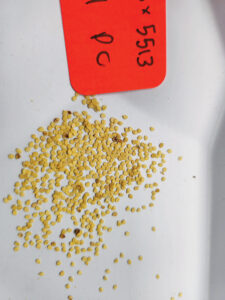
You just have to trust the process and trust that, in later years, you’ll get better- quality data and you’ll be able to make better-informed decisions. In the later- stage part of the program, it is pretty fun, because a lot of times, (cultivars)
will be planted right next to commercial, and you’ll see, ‘Wow, this red line is outyielding Dark Red Norlands, and that’s pretty widely grown.’ So if I can
get enough data to substantiate this observation, I can show this to farmers, to seed growers, and say, ‘Hey, this is something that we really should consider commercial-wise.’
Have you had any notable successes so far?
PC: Not directly, no. The previous breeder retired about two years before I started. The technicians that worked for the program continued to plant and replant some of the breeding program and the variety collection at the farm, but they really weren’t introducing new things into the pipeline. So, I’ve inherited some lines that I could see with potential. I have a few chippers that are moving through National Chip Processing Trials, but my focus has really just been on restoring the capacity of the breeding program.
Will that be the ultimate satisfaction, to see something you helped create achieve widespread availability?
PC: Exactly. The reason I was interested in plant breeding was the potential for huge impact, to farmers, to consumers, to really everyone in the food value chain. Sometimes it kind of feels like you’re just scratching off lottery tickets hoping to find one, but if you find that one, that can have a huge impact. There’s also perks. You get to be the first person to taste a new potato clone. That can be fun.














